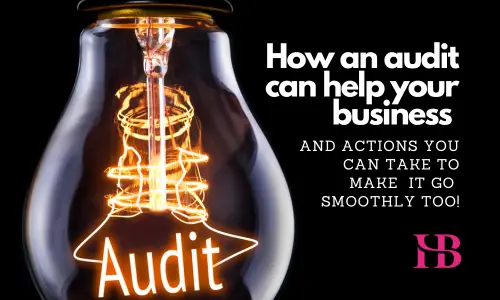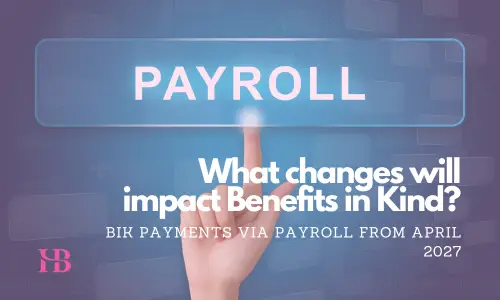A financial forecast is an important tool to help you understand the steps you need to take to grow your business or remain profitable. In business, many factors are beyond your control but it’s invaluable to know what to expect in the near future and plan ahead. This is where financial forecasting will help. Here is the HB guide to the value of a financial forecast and how to implement financial forecasting across your business.

What is financial forecasting?
Financial forecasting is when you predict your business’s future financial performance to produce a financial forecast that clearly displays the direction your business is headed in, based on past performance and other factors. A forecast works alongside your budget and helps to make your budget more accurate.
Your financial forecast can cover whatever set time period you decide is appropriate. For example, it could cover the next 6 months to 1 year, which is useful for forecasting your future business performance so you can flex your expenditure or pivot the focus of your sales team, for example. Or it could be a projection over 1-3 years, which is useful if you are looking for investment or to sell your business.
Why financial forecasting will benefit your business
A financial forecast is useful to:
- Establish realistic business goals – whether your business will grow or even decline.
- Identify potential future issues giving you time and knowledge to address them before they impact your business.
- Reduce the financial risk from overspending. Your budget may indicate you have cash to invest, however, the financial forecast may indicate the need to tighten your belt in the near future.
- For potential purchasers or investors . Investors use a company’s financial forecast to predict its future performance. It also shows that you have a firm grasp
4 common types of financial forecasting
There are four common types of financial forecasting:
1. Sales forecasting – predicting the volume of products or services you expect to sell within a stated time period. Sales forecasting supports budgeting and helps with planning production cycles. It also helps companies manage and allocate resources more efficiently.
To create a sales forecast, you need a goal for sales in your determined time period. Then you need to create a production schedule that allows you to reach the goal over your set time period. Remember to plot the increased costs associated with this extra production including cost to produce and cost of sales and marketing.
2. Cash flow forecasting – estimated how much cash will flow in and out of the company over a stated time period based on income and supports budgeting. If your cash flow is negative, it means you’re not going to have enough cash on-hand to run your business, according to your current trajectory. You’ll need to make plans to borrow money and pay it off.
If your net cash flow is positive, you can plan on having enough surplus cash on hand to pay off loans, or save for a big investment.
3. Budget forecasting – aims to determine the ideal outcome of the budget, assuming that everything proceeds as planned.
4. Income forecasting – by analysing the company’s past revenue performance and current growth rate to estimate future income. It is integral to doing cash flow and balance sheet forecasting. Additionally, the company’s investors, suppliers, and other concerned third parties use this data to make crucial decisions. For example, suppliers use it when determining how much to credit the company in supplies.
How to create a financial forecast
In short, there are three steps you need to follow:
- Look at your previous financial statements. These are used to project your income, cash flow, and balance.
- Gather any other relevant records: Is there any other data you can draw on to make your projections more accurate?
- Analyse the data and prepare your statements.
At each stage, you have to be accurate, so here’s a more detailed explanation.
1. Define the purpose of your financial forecast
What do you want to learn from the financial forecast you are preparing? Determining your financial forecast’s purpose is essential to work out which metrics to use.
2. Gather past financial statements
To create a forecast you need to analyse historical data otherwise you’re just taking a guess about the future. You will probably want to look at your previous income and revenue, expenditure and losses, liabilities, investments, equity and fixed costs.
3. Choose the time frame for your forecast
The usual financial forecast spans 1 year as a forecast is usually more accurate over the short term. However, if you are looking for a loan, you may need to forecast over 3-5 years.
4. Choose a financial forecast method
There are two methods to create a financial forecast but most forecasts use a blend of both. One is quantitative, based on all your historical data to identify trends and reliable patterns. The other is qualitative, based on research and expert opinion. The blend you choose will depend on your needs and the resources at your disposal – this should not be an expensive or time-consuming task, although some investment of both is likely to be needed. Qualitative forecasting is more suitable for startups without past data.
Quantitative – Look at your last few annual income statements, cash flow and balance sheets to see how you’ve grown in the past. From there, you can make a guess about how you’ll grow this year.
The benefit of this is that it’s relatively easy to do and doesn’t take a lot of time, money, or expertise. The drawback is that you’re only using info about your own business, and not looking at broader market trends—like what your competition has been up to.
Qualitative – By considering how your industry has performed over the past ten years, looking at any new technologies and investigating consumer trends and measuring the progress of your competitors you can create a detailed, nuanced view of how your business could grow.
The drawback is that researched-based forecasting can be expensive. You may find you need to hire outside consultants and researchers to handle the heavy lifting.
5. Document and monitor results
Financial forecasts are never 100% accurate and tend to change over time.
HB Top Tip: Once you’ve created your forecast, we recommend that you update it regularly, especially when major developments happen.
6. Ongoing analysis
Regularly analyzing financial data is the best way to tell whether your financial forecasts are accurate. Additionally, continuous financial management and analysis helps you prepare better for the next financial forecast and gives you crucial insights into the company’s current financial
HB’s top tip: Humans aren’t very good at predicting the future. Consider creating three different forecasts: One for the best case scenario, one for the worst, and one for if all external business factors remain constant.
How can we help?
The HB team is always available to support your accountancy needs and discuss ways to boost your productivity.
If you feel that a financial forecast would support your business and you’d like to learn more, then give us a call! Not only can we support you with financial forecasting, we can tell you about all the other services available, discover how we can give you real confidence in the future of your business, or if you are a larger business that requires auditing, then contact us today. We’re accountants for business and we are here to help you grow efficiently.
The information contained above is for general guidance purposes only. Whilst every effort has been made to ensure the contents are accurate, please note that each individual has different circumstances and it is essential that you seek appropriate professional advice before you act on any of the information contained herein. HB Accountants can accept no liability for any error.
Read our latest blogs below
- HMRC Advisory Fuel Rates (AFRs) from 1st June 2025
 HMRC has published the latest Advisory Fuel Rates (AFRs) which apply from 1 June 2025. AFRs are the official rates used when reimbursing employees for business mileage in company cars. They’re reviewed every quarter (February, May, August and November) and adjusted in line with fuel prices.
HMRC has published the latest Advisory Fuel Rates (AFRs) which apply from 1 June 2025. AFRs are the official rates used when reimbursing employees for business mileage in company cars. They’re reviewed every quarter (February, May, August and November) and adjusted in line with fuel prices. - How an audit can help your business (and actions you can take to make it go smoothly too!)
 An audit may be a legal requirement for your business but a well managed audit can also boost your business growth and ensure that it is operating in the best way possible.
An audit may be a legal requirement for your business but a well managed audit can also boost your business growth and ensure that it is operating in the best way possible. - Why a budget helps you to focus on business growth
 Are you looking for clarity over the future direction of your business? Do you want to know the actions you should take in order to grow your business? Then consider taking time to create a budget for your business.
Are you looking for clarity over the future direction of your business? Do you want to know the actions you should take in order to grow your business? Then consider taking time to create a budget for your business. - How a SME Owner Can Create More Time
 SME owners and managers – are you part of the one in five small and medium-size enterprise managers that work on average an additional 3 hours a day on a regular basis? Or one of the 33% that claim that there just aren’t enough minutes in a day to get everything completed? (The Independent study … Continue reading
SME owners and managers – are you part of the one in five small and medium-size enterprise managers that work on average an additional 3 hours a day on a regular basis? Or one of the 33% that claim that there just aren’t enough minutes in a day to get everything completed? (The Independent study … Continue reading - A New Academic Year for our Student in Zambia
 As the new academic year unfolds in Zambia, we are delighted to share an update about our sponsored student, Getrude. Currently in her second year at Chalimbana University, Gertrude is studying Business Administration in Accounting and Finance.
As the new academic year unfolds in Zambia, we are delighted to share an update about our sponsored student, Getrude. Currently in her second year at Chalimbana University, Gertrude is studying Business Administration in Accounting and Finance. - Benefits in Kind via the Payroll
 From April 2027, Benefits in Kind (BIK) payments will need to be paid and recorded via payroll each month. Businesses need to prepare for this change.
From April 2027, Benefits in Kind (BIK) payments will need to be paid and recorded via payroll each month. Businesses need to prepare for this change.

